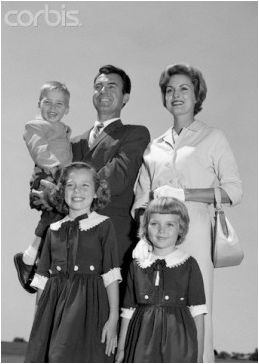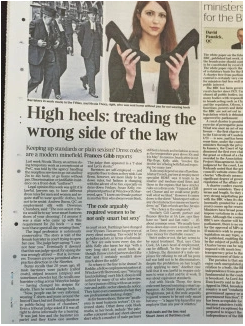By Amanda Jackson, Executive Director WEA Women's Comission
When I was a girl (OK, it was a fair while ago) we all wore our best clothes to church. My mum made me a Sunday-best-dress – one for summer and one for winter all through my childhood. As the youngest of three girls, I wore a lot of hand-me-downs so the Sunday dresses, which also served for birthday parties, were a real treat, made specially for me.
My mother always looked smart for church – gloves, stockings and a hat were de rigueur. My parents’ generation  saw their suits and frocks as an outward sign of respect for God and the church. It was also a show of respectability, that whatever your economic circumstances, you put on your best for the Lord’s day.
saw their suits and frocks as an outward sign of respect for God and the church. It was also a show of respectability, that whatever your economic circumstances, you put on your best for the Lord’s day.
 saw their suits and frocks as an outward sign of respect for God and the church. It was also a show of respectability, that whatever your economic circumstances, you put on your best for the Lord’s day.
saw their suits and frocks as an outward sign of respect for God and the church. It was also a show of respectability, that whatever your economic circumstances, you put on your best for the Lord’s day.
Clothes were made to last and be versatile (if a little formal). According to British Airways advice to women travellers in 1971, a woman should be able to go anywhere by packing:
3 dresses, 2 vests, 2 pairs gloves, a twin set, an evening dress with bag and shoes, a wool stole and a girdle[1].
How fashion has changed! And thankfully so, because it is more relaxed for both men and women. There is more choice and the rules are less strict.
But in some ways, clothes and fashion are more complicated. With that loss of meaning for ‘Sunday-best’, we have also lost respect for quality and we care not at all who makes our jeans, tops and trainers. My mum would update old clothes with a new hemline or added ribbon. She carefully darned and patched everything and passed on those skills to me. Clothes were worth mending because they were expensive to buy.
Women could not get access to credit cards until 1975 (that’s only a generation ago) so paying for clothes by ‘lay-by’ was popular. My mum and millions of other women would put down a deposit for a jumper or coat, which the store then set aside. And then week-by-week, women would pay off a bit more with no added interest. There was lots of anticipation and it taught families to see such purchases as special.
Now, at one end of the shopping mall or high street we have cheapened clothes so much that I can buy three t-shirts for $10 while at the other end of the mall, we aspire to own shoes and bags that cost a week’s wages. We buy on credit and don’t have to budget or save.
We think we have fashion freedom to define our own style but we are part of a globalised fashion industry that is worth a staggering US$1.5 trillion a year[2]. Just one brand, Zara produces 900 million garments annually.
So our ‘freedom’ or empowerment is a joke. We are part of an industry that entices women to buy clothes every month (stores like Primark, Forever 21 and H&M add new clothes every fortnight!)
 We are told we ‘should’ wear high heels at work to look professional. And we face the sack if we complain as Nicola Thorpe found out in London last month. A temp receptionist, she was sent away from a London financial company for refusing to wear high heels. The dress code said she should wear 2-4 inch heels (5-10cm)[3]. So the question has to be, how does such a rule help her to do a better job? Or is it just a bit of sexism?
We are told we ‘should’ wear high heels at work to look professional. And we face the sack if we complain as Nicola Thorpe found out in London last month. A temp receptionist, she was sent away from a London financial company for refusing to wear high heels. The dress code said she should wear 2-4 inch heels (5-10cm)[3]. So the question has to be, how does such a rule help her to do a better job? Or is it just a bit of sexism?
We may not wear girdles but we submit to high heels or botox or breast implants!
Blogger and academic, Professor Mary Kassian reminds us about being wise in the way we look after the things God has given us and that includes our clothes[4]. She quotes Luke 16, Whoever is faithful in very little is also faithful in much, and whoever is unrighteous in very little is also unrighteous in much. So if you have not been faithful with the unrighteous money, who will trust you with what is genuine? And if you have not been faithful with what belongs to someone else, who will give you what is your own?
Kassian reminds us “to be intentional about putting some strategies in place to be a good steward of what God has given you.” Maybe the concept of Sunday-best can still be a good guideline if it means we are showing respect for God’s provision and those who grow and make our clothes.
[1] For anyone under about 50, a girdle was like today’s body shaper, designed to hold up stockings and hold in your tummy. It also made you hot and uncomfortable.
[2] https://www.penguin.com.au/products/9781863958356/wardrobe-crisis-how-we-went-sunday-best-fast-fashion
[3] http://www.huffingtonpost.co.uk/entry/high-heels-receptionist-sent-home-pwc-nicola-thorp_uk_573324b4e4b0e6da49a72f9f
[4] http://girlsgonewise.com/dos-and-donts-for-your-next-wardrobe-crisis/





Stay Connected